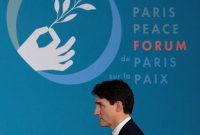Support strong Canadian climate journalism for 2025
Social media websites like Facebook and Twitter now take in the lion's share of federal advertising dollars, thanks to an ongoing increase in the use of digital advertising by government departments and agencies, new figures show.
Of the $39.2 million spent on government advertisements last year, federal departments spent almost $18.2 million on digital ads — roughly 46 per cent of the total budget, which doesn't include production costs.
And, for the first time ever, social media ads made up the biggest slice of digital spending — 43 per cent, or roughly $7.8 million.
"Canadians are using more digital platforms and with greater frequency, and therefore expect their government to communicate with them on those channels," says the government's newly tabled annual report on advertising activities.
"Departments challenged their creative agencies and the (advertising) agency of record to 'spread their creative wings.'"
Ads on Twitter, LinkedIn and Snapchat featured prominently in the government's digital ad buys for the 2017-18 fiscal year, but the vast majority — 73 per cent — of the government's social media spending went to Facebook.
The report points to statistics showing Facebook had a 75 per cent reach among Canadian internet users, double that of Twitter.
"Further, Facebook allows for niche-targeting and it generally has high engagement rates," the report states.
"Twitter, on the other hand, is used more for 'breaking news' and has more limited targeting options."
Meanwhile, last year marked the lowest amount spent in over a decade on traditional advertising outlets like newspapers and television.
Print outlets received about $570,000 while radio received almost $392,000, roughly 1.4 and one per cent, respectively, of the advertising budget.
Television ads, which had long been government's advertising medium of choice, received about 11.5 per cent of the ad spend last year, or $4.5 million.
The shift away from television to online is the result of a policy change in 2016 that saw federal organizations adopt a digital-first approach for communications.
Federal officials have yet to respond to a request for comment about the digital advertising strategy.
Bob Cox, chair of News Media Canada and publisher of the Winnipeg Free Press, says he is concerned this policy not only hurts traditional media outlets like newspapers, but also means some, mainly older, Canadians are not seeing federal messages.
"Every time something new comes along, people rush to the new thing and ignore the old thing," he said.
"We've always argued, and we feel justified in making these arguments, that some of the audience is found in social media, some of the audience is found online and some of the audience is found in traditional newspapers. People didn't rush away from newspapers. We still sell a lot of newspapers here in Winnipeg."
Cox, who is lobbying the government to spend more on advertising in traditional media outlets, argues the digital-first marketing strategy is "off-kilter."
"They're forgetting a large swath of the population, pretty much anybody over the age of 55, who focuses on newspapers or who trusts the newspaper, they're not reaching those people. So whereas they may be effectively reaching some people, it's not the only way to reach people and that's what I find so disconcerting about it, it's bad marketing."
Cox did say he believes government has redirected some spending on newspapers as part of Ottawa's attempt to help the struggling news industry.
The Liberals are also planning to roll out nearly $600 million in new tax credits and incentives for the Canadian news industry over the next five years.





Comments